Evidently when I say I’ll make a followup post in a few days, this is code for in a few months. I apologize for that. Once home I was busy and quite frankly, I don’t know a lot about the Stuarts who were the feature family for my last three days in the UK.
My stay in Stirling was different from the other three towns. I was in a lovely Airbnb but it was located on the outskirts of town, over a mile’s walk from the city center. So while I made my visits to various places, I did little in town once I was finished with that. Once I’d made my visits and got back I never felt up to walking the mile or so back to look for a pub or restaurant.
After leaving Lancashire I had a little time the first evening so I walked about a bit, including to a market. I was able to see the newer version of the Stirling Stone Bridge. The original which features so prominently in the Battle of Stirling Bridge was taken down and replaced by a 15th century version. It’s still stone and old. However this bridge is substantially wider than the one that existed in the 13th century if the accounts of the battle are at all accurate. Rather than only being able to ride horses two abreast I suspect you could fit five or six.
The following morning was Stirling Day. There wasn’t great signage from where I was staying but the Castle is impossible to miss from anyplace in town. So I set off in its general direction and eventually came across a track up Gowan Hill which was marked. It was a good hike but the hill had some pretty steep grades broken by more level sections so it wasn’t too bad overall. And by this time I’d spent a month walking about 10 miles a day, sometimes up hills, so the hike was not a problem. There was a sign off to the side (and straight up) giving directions to The Beheading Stone. I mulled over going that way, googled the stone and looked at some pictures, and thought better of it. I’ve seen rocks before.
I reached the Castle a little before opening and wandered around a bit. Stirling Castle gave me a different impression than most of the English castles I had seen. In England they tended to be tall, with, in most cases, towers and spires; projecting wealth, majesty and power. Stirling was different. It has a lower profile, is blocky and massive and seems to be a part of the earth. It dominates the Stirling landscape and the Forth valley and looks almost like an extension of the natural rock formation. I’m not sure how to accurately describe this impression.
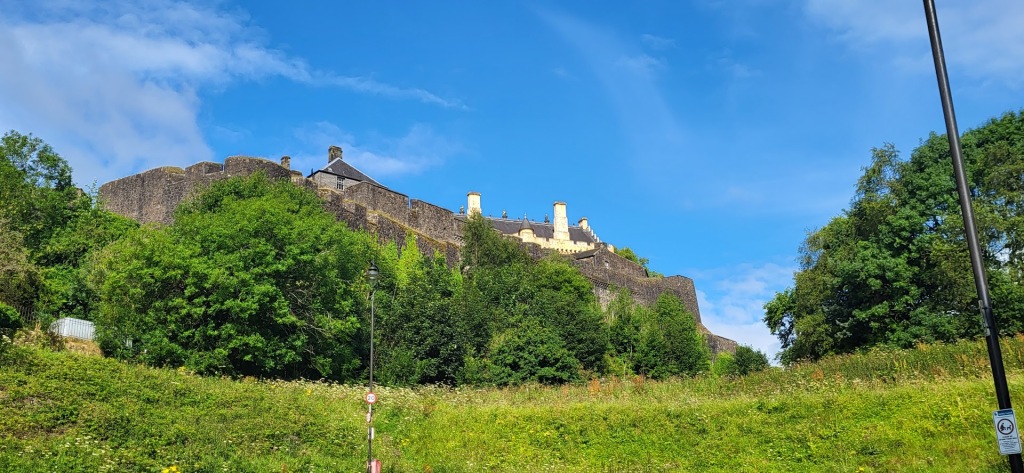

There are a couple of interesting features inside the castle, some medieval and some not. There was a fair amount of emphasis placed on the Stirling Heads. These are round wooden carvings created around 1540 under James V. The subjects of the carvings range from important contemporary and historical figures to mythological. They were also fascinated by unicorns.
Within the castle are various displays and exhibits so you can see, for example, the Queen’s Hall, the King’s Hall, waiting rooms, etc.
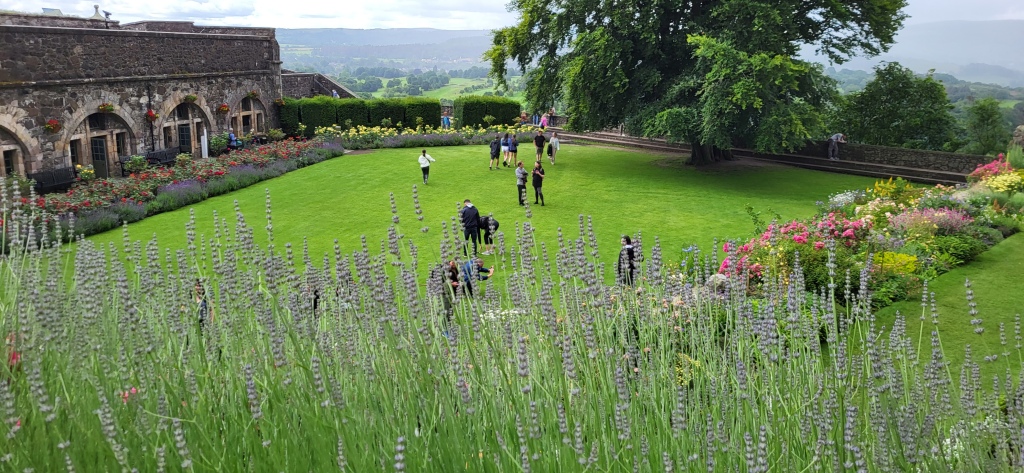
Following Stirling Castle I went to the Church of the Holy Rude. Yes, this is the name, people think I’m joking when I say it. The name stems from The Holy Rood, the True Cross. The first Church on this site was built in the 12th century but it burned down. The present structure dates from the 15th.
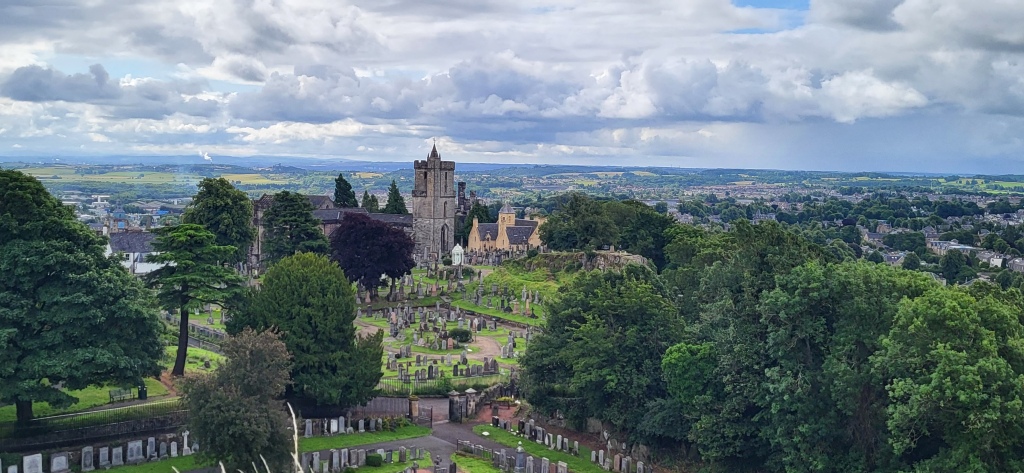
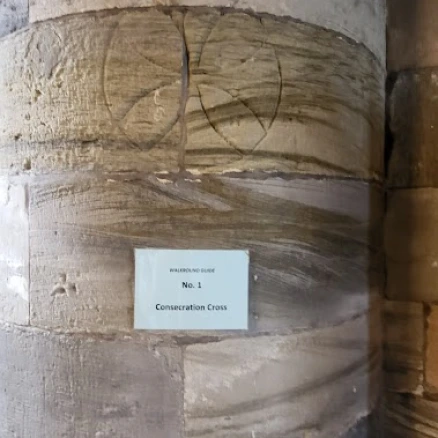
The next day I visited Edinburgh – pronounced Edin-borough for ignorant Americans like I was before this trip. The first thing you see on exiting the train station is The Scott Monument, in honor of Sir Walter Scott. I wandered over and walked around but I was there well before it was open and am not sure I’d have bought a ticket in any case.
I had decided before leaving that morning that the Cathedral and Castle were my two main spots to visit and they were not hard to find from the station.

There was a decent climb but I wouldn’t rate it on a scale of UK hills as much of it was stairs. It was quite easy to navigate however. Once you finish the stairs you come out on High Street and The Royal Mile.
I had a little time before the Kirk opened so I strolled up and down the street. I’ll mention that there are two items prevalent in Scotland which leaves little doubt where you are – kilts and whiskey. There was a museum nearby, The Scotch Whiskey Experience. I did not tour the museum but visited the gift shop where they had for sale the smallest bottles of booze I have ever seen. Think of the little ones you see on flights, then scale those down to about 1/10 the size. If you want to get a pet mouse drunk these would be just the thing.
St Giles was impressive, as were all of the cathedrals I saw in the UK. There was a church on site from the 12th century but the present structure dates from the 14th.

From the Cathedral I made my way to Edinburgh Castle. Similar to Stirling, it was more massive than towering. It was also a Royal Residence.
There was a lot to see here. Various rooms the Royals lived and worked in, guard halls, kitchens, etc. They also have a unique feature, the One o’clock Gun. Basically, they fire the gun each day at 1 p.m. Crowds gather near where the gun is placed and wait for it. It reminded me of people clustering around the Prague Astronomical Clock. I myself did not wait around for the gun to fire but was on the grounds when it did and it’s loud. I did not enter a large section of the castle. The Scottish Crown Jewels are housed in what is called The Royal Palace and there was a long line so I passed on it.
After leaving the Castle I ate lunch at a nearby pub and checked one more item off my to-do list by having haggis. It was good. Somewhat spicy but not overly so. I’d have it again.

I wandered around High street and the Royal Mile for a bit before heading back to Stirling. It is quite the tourist trap and at the time I was glad I wasn’t with a companion or I’d have likely been wondering how to ship things home. If shopping is your thing I highly recommend it.
For my final day I had originally decided to visit Glascow. This made sense, right? I had three days so I’d take in Stirling and the two largest Scottish cities. But on the train back I started looking at what medieval sites there are in Glascow and didn’t come up with much beyond the Cathedral. I was half convinced I’d do something different and asked my airbnb host who confirmed that Linlithgow would be worth a visit.
I don’t know what I might have seen if I’d stuck to my original plan but in retrospect I was quite glad I changed it. The town is the site of a royal palace constructed beginning in the early 15th century and is the birthplace of Mary, Queen of Scots. The palace is well-preserved and makes for a very nice place to visit. It happens to be one of the sites without roofs but in good shape otherwise. This is something I’ve come to appreciate as, when you are higher in the structure you can get a nice feel for the layout. Conwy Castle was another similar location.

You could walk around several levels of the palace, an inner courtyard, and below the ground level were the kitchens and storerooms. They did not have furnishings, etc., such as were at Stirling and Edinburgh Castles. I really enjoyed this visit – if you’re in Scotland I highly recommend it.

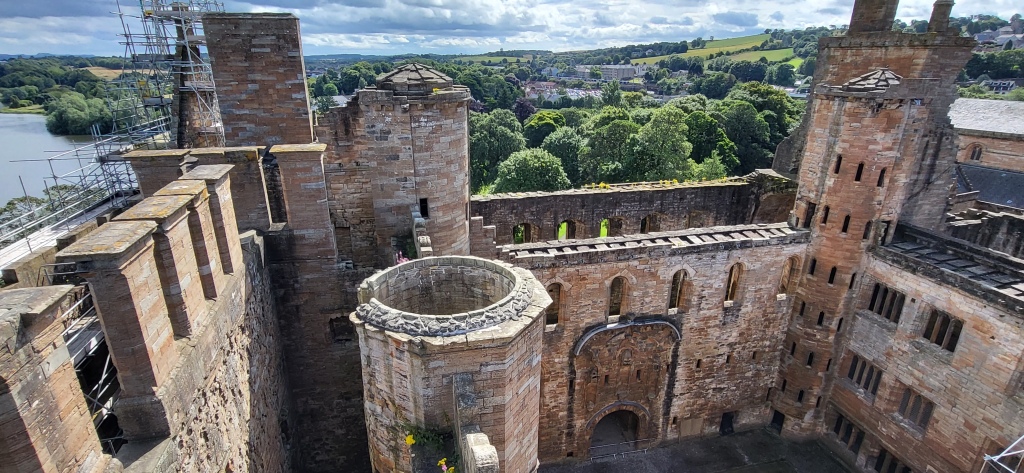
For those thinking of visiting, not just the UK but any place, I encourage you to think about visiting some of the less famous sites. Linlithgow makes a nice example of why. When I visited a large site like the Tower of London or Lincoln Castle, people there were very businesslike – and busy. At Linlithgow, those working the site were students on their summer jobs. They had a passion for and ownership of the site you don’t see, or I didn’t anyway, at these busier locations. I spoke with a couple of them shortly after entering, spent several hours walking around, and spoke with them again. There are portions of the palace where all levels were intact but in other areas only the walls remained and the levels above the ground were gone. There was a lot of renovation going on – you can see the scaffolding in most of my pictures – so I asked if there were plans to restore the upper floors.
I was surprised by the response, “We’ve talked about it. The problem is that we don’t know exactly how they were laid out or what the different rooms were for. We don’t want to do something historically inaccurate.”
I felt the same sense of ownership and enthusiasm visiting Debbie at The Halls in Norwich as I did here. And I had the same experience visiting local churches where parishioners rather than the National Trust were in charge. Nothing against the larger sites or those working at them; they do a great job. But I really enjoyed having the time to have one-on-one conversations with people who didn’t have to worry about a crowd moving through a section of a castle.
Right next to the palace is St. Michael’s Church. It was first built in the 13th century but most of the present structure dates from the 15th when it was rebuilt following a fire.
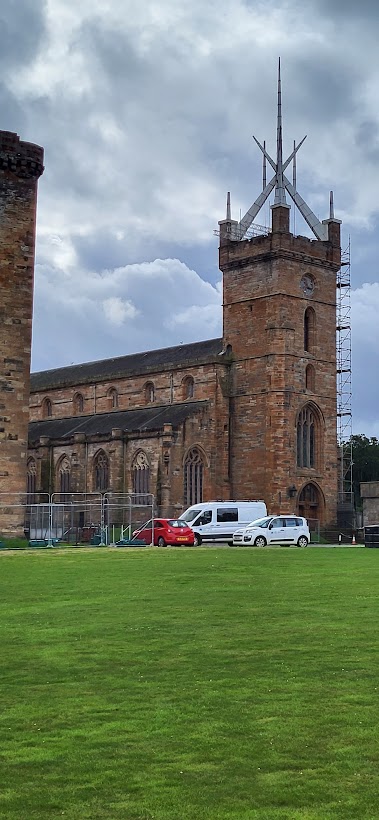
I wanted to show one image of a stonecutter’s mark. I believe this was first pointed out to me in Norwich. As a church was being built or undergoing major renovations, numerous stonecutters and stonemasons would be hired for the project. Each of these craftsmen would have a distinctive mark to place on something they were responsible for. I started taking pictures of these during the trip.
Linlithgow was my last tourist day in the UK. One place in Stirling I did not visit was the William Wallace Monument. I kept thinking I would but it closed by, I believe, 5 p.m. in the evening and was a good distance from where I was staying. The following day I traveled to London, stayed overnight at a hotel and caught a flight home the next day.
Summary of my UK Trip
I really enjoyed my 33 days in England. In retrospect my decision to turn the rental car in was the correct one. I did miss popping by some small farm or eating at an out-of-the-way restaurant. However I could get just about everywhere I wanted to by rail and this was quite affordable. If I visit again I won’t even think about a car. Without a car I had the added benefit of getting in a lot of walking. I had days where I made as much as 18 miles, others with as little as 3 but I suspect I averaged about 10 – I saved screenshots from my phone app but haven’t bothered to tally them. Other than a few very warm days I enjoyed this.
Much to my surprise, as time went on I found myself more interested in churches and cathedrals than castles and royal residences. It’s hard to explain why but each cathedral I visited exuded its own character.
If I visit again – and it’s tempting – I’ll focus on the southern part of the country, from Kent to Cornwall. I do think I’ll stay 3-4 days in Norwich. This was my favorite place to visit and even after two days I feel there’s more to see. Also, I didn’t visit Sutton Hoo. I don’t have a good reason for this. It’s near a a rail line and not too long of a trip from Cambridge. I’d like to see Stonehenge as well. And I’ll probably incorporate some time for Ireland into it.
A few favorites from the trip:
Favorite Castle – This is a tie between Lincoln and Conwy. Lincoln is much larger and more impressive but there’s something about the utilitarian nature of Conwy – it has one purpose and being a nice place to live isn’t it.
Favorite Cathedral – I think Durham because of the history with shrines to both Bede and Cuthbert. Westminster Abbey and York Minster were certainly impressive though.
Toughest Climb – It’s a close choice but I’m picking Lincoln Castle and Cathedral. The main reason is it’s straight up on a city street with no let-up, unless you want to pop into a pub or shop. It was also quite warm the day I visited. Stirling Castle may be as much of a climb but it’s broken up and some is in the shade. Durham gets an honorable mention as you get to climb twice – the cathedral is up on the river bank and so is the train station – on the other side. Dover also looks impressive but as it was raining we took a cab up though we walked down.
Favorite place I stayed in – Shrewsbury. I loved the old town feel. Everything is circular and cobbled plus my airbnb was right in the heart of town. Though The Clarendon Arms in Cambridge was my favorite pub.
Favorite Meal – I’m going with the Fish and Chips at Clarendon Arms. I had Fish and Chips four times. Once in London where I almost gave up on it. Also at Newtown and Linlithgow which were quite good. But Clarendon Arms was the best. I will say the the English are very creative with what they do with a burger.
Next Trip
I had been thinking that I would spend a month in Italy this coming summer. I have set that aside. My next big trip will be to spend a month or so in France in 2025. I might have visited this year except for Paris hosting the Olympics. I’d prefer not to be around while the setup is going on for that. This is probably a good thing as I have just started taking a French Class. I have a little French but I won’t be going someplace for a month unless I can carry on a conversation in the native language. Italy will have to wait for 2026.
This year I am tentatively looking at going to Prague for 10-14 days in September. I spent three days there a little over a year ago and loved it. And the historical sites are great. Unlike for much of Europe, these were not damaged in World War II. It is an exception to my previous language statement – so few people (internationally) speak Czech and it’s such a prominent tourist destination that English is quite prevalent. I’ve been told Holland is similar.
So this was my first big international trip. I could ramble on for another thousand words but will leave off here. I enjoyed England and being able to visit some iconic historical sites was outstanding. I am certainly open to visiting again. There is a lot yet to see.










One response to “The Final Leg: Scotland and the Stuarts”